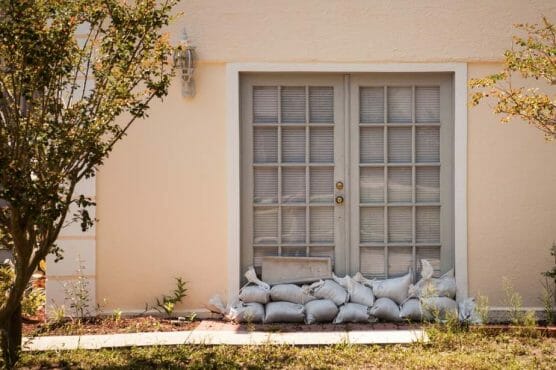Quick Navigation
Don’t wait till it’s too late! Make a door flood barrier and protect your property now!
Flooding can be devastating for everyone, especially during home flooding. Increasing climate change issues have led to natural disasters happening more commonly and at a high cost for people. If you live in an area that has experienced floods or is at risk from flooding, you need to prepare as much as possible in advance. We are here to provide you assure that you and your property are safe from floods.
Doors are one of the first lines of defense and the least impermeable part of a property. In a flood situation, water gets into the property if it is not sealed properly. Building defenses is costly but provides more benefits and safety as compared to having no defenses. They are one of the more economical options. They prevent floodwater from entering the property and limit flood damage. Door flood barriers come in various forms that are efficient in keeping the water out and the damage to a minimum.
However, before making a flood door barrier, you need to determine various things, such as whether the door opens in or out. If the door opens in, the flood barriers need to be fit externally, and if it opens out, the flood door barriers are suggested to be placed inside the door. Similarly, the dimensions of the doors, such as their width and depth, and the height of the door from the road are required to be assessed before making and fixing it.
They can be made in various ways such as sandbags, inflatable flood bags, strips, flood doors, and more.
Sandbags

Sandbags are the traditional favorites to use as a door flood barrier. Sandbags are made up of woven hessian, which absorbs moisture and stops water from getting inside. All you need to do is:
- Fill them with sand
- Place them outside the door
Place sandbags upon each other to prevent floodwater from entering through them. More sandbags can be added to increase floodwater resistance in raising the height of the flood door barrier. Sandbags can be used to create a barrier within 10 to 15 minutes, depending on the bags and requirements.
In addition, you can place sandbags inside the door, but remember, don’t make a pile inside as it will limit the door opening capacity. Sandbags can be used once they are soaked in water, so place and use them in need instead of testing during the flooding season as it will impact its resisting abilities.
Inflatable Flood bags
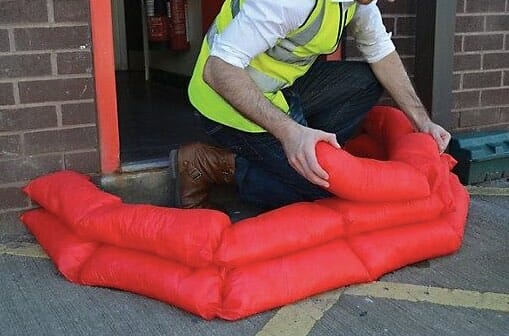
Inflatable flood bags can also be used as a flood door barrier. They are easy to move, store, and are more effective in limiting the flood water entering into the property. It takes less than 7 minutes to inflate and install inflatable flood bags on the entrants. You can place layers of flood bags to improve its resistance and ability.
This type of flood door barrier enables quick expansion, improving the response to rising floodwater. You can choose the lengths of the bags as per your needs by measuring the door width and use specialized air tools or normal air pumps. To increase its efficiency, you can:
- Increase the number of layers vertically
- Increase the number of layers horizontally
By adding vertically, you will be able to increase the height of flood door barriers, and by adding horizontally, the width and resistance will be improved.
Flood Traps
Flood traps can be placed on the corners of the doors to limit the entry of floodwater inside the property. To make the flood door barrier, you need to purchase a dry flood trap and either fit it dry or inflated. For non-saline surface floods such as rain, you can make layers of the flood trap sheets and place them on the corners of the door; however, to ensure that the sheets are stuck on vertical corners, you might need to wet the sheet slightly. After fitting the dry strips, the flood traps will be automatically activated by the floodwater. (1)
At the same time, for seawater floods, half of the strips are required to be soaked in tap water to ensure that the salty floodwater does not penetrate. The water activates the water-proof gel on the strips, which is required to be placed on the outside part of the door, while the dry section needs to be placed on the corner fillers of the doors. Similarly, lay vertical strips on the vertical part of the door frame, and ensure that the corners are filled. The vertical strips can also be strengthened by tapping the strips to ensure that there are no gaps on the door frame.
For improving the strength of the flood door barriers, you can add dry strips inside the door and fix them through tapping to increase the resistance of the flood door barrier from floodwater pressure. The strips can be placed in about 5 minutes, apart from the pre-soaking time that is additional 5 minutes.
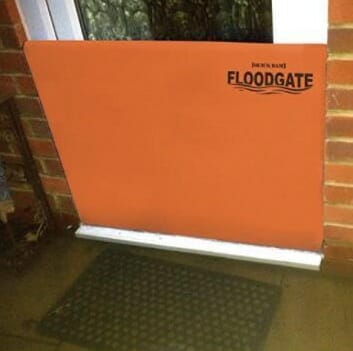
Flood gates
Flood gates can be used as an alternative or permanent fixture to the doors. You can fix the flood gates on your doorframe through adjustable steel clips, while the frame will be fixed as per the dimensions of the door. The flood gates include multiple options such as wood, concrete, or steel. The stoned material of the flood gates enables protection of the property and stopping floodwater from entering from the door.
You can also make flood gates by assessing the door frame measurements and making a gate to fit in the doorway. The strength of the flood gate, its height, and material can be based upon the requirement and level of floods you experience in your area. The flood door can be fixed through clips and bolts that strengthen the ability of the barrier against the flood intensity.
It can be installed in under 5 minutes that makes it one of the most reliable flood door barriers. Flood gates protect from floodwater, along with having flexibility on the sides to meet the door reveal. You can also add inflatable bags or flood traps to improve the seal around your doorway. In addition, it can be made of a hydro shield, aluminum, or HD aluminum that can be added to the bottom of the door to make it a flood door barrier. Different panels of the products can be added to increase the barrier ability and deflect the floodwater away from home.

Water-Activated Flood Barriers
For areas that are at more risk for floods, water-activated flood barriers protect the doorways from flooding. The barrier becomes activated upon contact with water, and within 10 minutes, expands to reach a height of 3.5 inches. You can lay the barrier outside the door, either directly in front of the door or make a formation outside the door.
The polymer that is considered to be a super absorbent and swells when in contact with water can be used in making the water-activated flood barrier. The more absorbent the polymer that is used, the more effective the barrier is. Place the barriers based on the door width and depth, along with placing at least one barrier behind the first barrier to ensure its resistance.
Utilizing its self-opening method results in time and effort in installing and fitting the barrier. However, water can lift up the barrier, due to which it is necessary to ensure there is weight on the sides of the barrier so that it does not move from its place. Once the water is absorbed, the barrier acts in pushing the water away from the door.
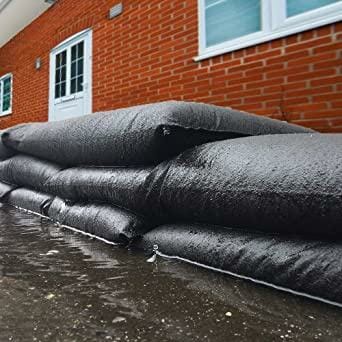
UPVC flood door
UPVC (Un-plasticised Poly Vinyl Chloride) flood doors are suitable for single and double doors that include a wide range of styles. The flood door not only saves you from the flood water entering the property but also improves the aesthetics of your property. It acts as a flood door barrier for areas that are subjected to lower flooding levels. UPVC flood doors are becoming a popular passive flood defense measure that you can add to your property and make your normal door a flood door. (2)

The resistance ability of the doors can be improved based on the materials chosen, such as aluminum or timber reinforced foam panels. This flood door barrier does not require any additional service or product, reducing your concerns during the flood season.
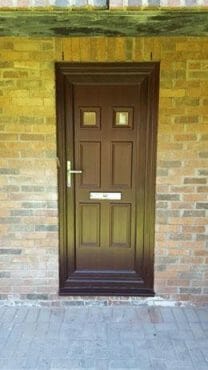
More Tips to Protect Your Door from Flooding
One of the easiest processes through which gaps can be fixed is through a self-adhesive seal strip. One of the other processes is using a plastic sheet at the bottom side of the door with the help of water-resistant adhesive taps. Better results can be obtained by combining the seal strips with the plastic sheets.
For the gaps that are smaller in size and are less than 1/8 inch, silicone caulk can be used, but one thing that needs to be considered is that silicone caulk cannot be easily removed in comparison to the plastic sheet or the seal tape.
In addition, you can use an absorbent sock on the inside part of the door in case there would be some leakage at the bottom. The absorbent sock can be placed in both situations, having placed flood door barriers or not, as it enhances the ability of the barrier.
Summary
Since floods are becoming more common from a decade phenomenon to a seasonal trend, making flood door barriers will save your items, property, and cost of repairs. There are multiple options from which you can choose the best fit solution to save for your property. Doors are typically a house’s weakest spot in terms of water protection. Keeping in mind the landscape, in the situation of flooding, houses are at high risk of penetration of water through doors.
Therefore it is considered critical to strengthening them over a period of time. As discussed earlier, it is quite possible to seal the entrance of the doors from floodwater. In order to obtain the best outcome, it is recommended that the first two methods should be considered and chosen from.
The guide presents easy options to create your own door flood barriers You can always come up with your own ideas and share them with everybody if they are successful.
References
(1) non-saline surface floods – https://www.sciencedirect.com/science/article/pii/S0167732218350761
(2) UPVC (Un-plasticised Poly Vinyl Chloride) – https://www.diffen.com/difference/PVC_vs_uPVC

